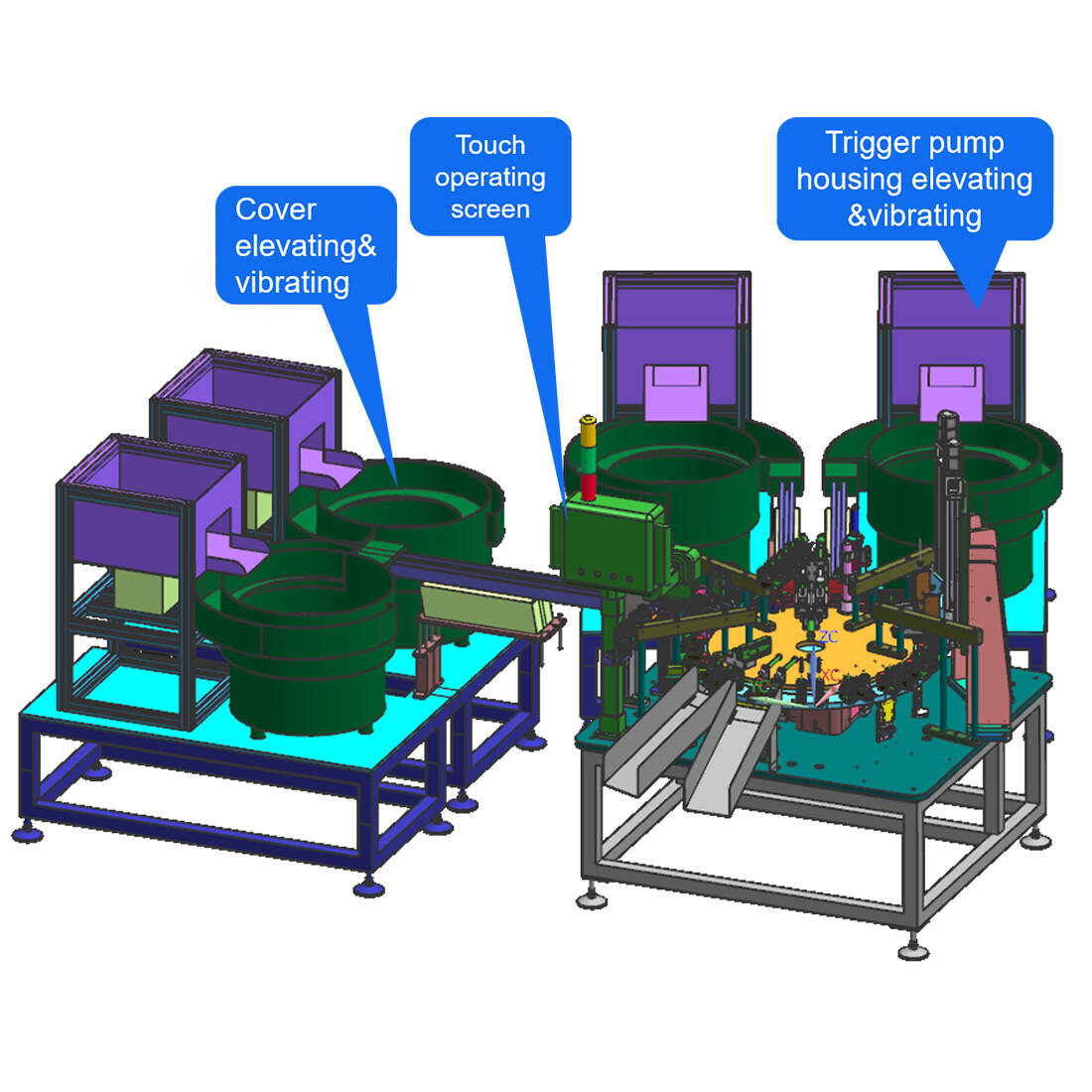Email format error
Email cannot be empty
Email already exists
6-20 characters(letters plus numbers only)
The password is inconsistent
Email format error
Email cannot be empty
Email does not exist
6-20 characters(letters plus numbers only)
The password is inconsistent


The Evolution and Importance of Trigger Sprayer Tube Assembling Machines: Revolutionizing the Manufacturing Process
In today’s fast-paced industrial world, automation stands central to enhancing efficiency. It plays a vital role in guaranteeing high-quality production outcomes. One groundbreaking innovation has profoundly influenced packaging and sprayer manufacturing sectors. This innovation is the trigger sprayer tube assembling machine. Designed specifically to automate trigger sprayer assembly, this equipment transforms productivity metrics. It simultaneously demonstrates technology’s power to streamline intricate procedures. For manufacturers and industry collaborators, comprehending such machines’ value proves critical. Understanding their operational mechanisms supports wiser business decisions.
What Constitutes a Trigger Sprayer Tube Assembling Machine?
A trigger sprayer tube assembling machine represents specialized industrial equipment. Its core function involves automating tube attachment to trigger sprayers. Trigger sprayers see widespread use in household cleaning products. They are equally prevalent in garden spray systems and personal care items. These devices comprise three primary components: a trigger mechanism, a nozzle, and an immersion tube. The tube extends downward into the product container. The assembling machine’s crucial role lies in efficiently connecting tubes to sprayer units. It guarantees tight, secure component integration every time.
Automation’s Impact on Trigger Sprayer Manufacturing
Prior to trigger sprayer tube assembling machines, assembly relied heavily on manual labor. This approach consumed substantial time resources. It also elevated risks of human-induced errors. Workers manually attached tubes to sprayer units. This process frequently resulted in quality inconsistencies. Production speeds remained constrained by human limitations.
Automation via assembling machines revolutionized this paradigm. Manufacturers now attain superior precision levels. Production speeds have dramatically increased. Output consistency reaches unprecedented reliability. These machines handle massive sprayer quantities autonomously. Minimal supervision requirements make them indispensable investments. Companies pursuing scaled production adopt them universally. Quality standards remain uncompromised during expansion.
Critical Characteristics of Modern Assembling Machines
Contemporary trigger sprayer tube assembling machines incorporate cutting-edge features. These attributes maximize functional optimization. Below are key differentiators defining these systems:
1. Rapid Operational Speeds
High-velocity performance represents a primary advantage. Depending on specifications, machines process thousands hourly. This output surge proves vital for high-demand production environments.
2. Micrometer Precision
Engineering ensures perfect tube alignment every cycle. Secure attachments eliminate connection failures. Defect rates plummet through mechanical consistency. Final products satisfy rigorous quality certifications.
3. Configuration Flexibility
Modern machines accommodate diverse sprayer variations. Adjustments handle different tube lengths effortlessly. Nozzle types and trigger designs adapt through simple recalibrations. No major system overhauls become necessary.
4. Autonomous Operation
Post-configuration, machines require minimal oversight. Labor cost reductions follow naturally. Error probabilities from manual handling disappear. User interfaces enable real-time monitoring. Quick parameter adjustments resolve most operational hiccups.
5. Waste Minimization
Precision engineering slashes material overuse. Tube and component waste decreases significantly. Rework demands diminish substantially. Overall production economics improve markedly.
Operational Mechanics of Assembling Machines
Understanding machine workflows clarifies efficiency advantages. While models vary, fundamental processes typically involve:
Stage 1: Component Preparation
The system loads individual parts systematically. Sprayer heads, nozzles, and tubes enter designated assembly stations.
Stage 2: Tube Integration
Mechanical arms position tubes accurately. Robotic systems attach them to sprayer heads. Connection security receives priority attention.
Stage 3: Bonding Procedures
Pressure application ensures physical stability. Thermal bonding or adhesives create permanent seals. Durability meets product lifecycle expectations.
Stage 4: Quality Assurance
Integrated sensors inspect each assembled unit. Defects like misalignments trigger automatic rejection. Flagged items undergo reprocessing protocols.
Stage 5: Final Packaging
Completed sprayers enter automated sorting systems. Some machines incorporate packaging modules. This creates seamless production-to-shipment workflows.

Strategic Benefits of Machine Adoption
Implementing trigger sprayer assembling machines delivers multifaceted advantages:
Benefit 1: Throughput Multiplication
Automation slashes assembly durations exponentially. Human teams cannot match machine velocities. Production capacities meet market demands effortlessly.
Benefit 2: Quality Uniformity
Consumer satisfaction hinges on product reliability. Machines guarantee identical assembly parameters. Defective product rates approach zero.
Benefit 3: Financial Optimization
Initial investments yield long-term ROI. Labor cost reductions accumulate progressively. Material waste minimization enhances profitability. Scalability occurs without linear cost increases.
Benefit 4: Workforce Reallocation
Automation liberates human capital from repetitive tasks. Employees shift to quality assurance roles. R&D departments gain reinforcement. Customer service capacities expand.
Implementation Challenges
While advantages dominate, considerations include:
Challenge 1: Capital Outlay
Premium machines require substantial upfront investment. Cost-benefit analyses must justify expenditures.
Challenge 2: Maintenance Demands
Regular servicing ensures peak performance. Technical staff and spare parts inventories become necessary.
Challenge 3: Operational Complexity
Machine programming requires specialized skills. Comprehensive operator training becomes imperative.
Implementation Roadmap
Transitioning to automated assembly demands structured planning. Below are actionable steps for seamless integration:
Step 1: Needs Assessment
Conduct thorough evaluations of current production volumes. Identify bottlenecks in manual assembly workflows. Quantify defect rates and labor cost allocations.
Step 2: Machine Selection
Research manufacturers specializing in trigger sprayer automation. Compare technical specifications across models. Prioritize adaptability to diverse product configurations.
Step 3: Workforce Training
Develop training programs for machine operators. Include troubleshooting protocols and maintenance routines. Collaborate with equipment suppliers for on-site guidance.
Step 4: Pilot Testing
Run small-scale production trials initially. Monitor output quality and machine reliability metrics. Optimize settings based on performance data.
Step 5: Full-Scale Deployment
Integrate machines into primary production lines post-validation. Continuously track efficiency gains and ROI metrics.
Future Trends in Sprayer Assembly Technology
The evolution of trigger sprayer tube assembling machines shows no signs of stagnation. Emerging innovations promise further advancements:
1. AI-Driven Predictive Maintenance
Machine learning algorithms will forecast component wear. Preemptive repairs minimize unplanned downtime.
2. IoT Integration
Real-time production data will stream to centralized dashboards. Remote monitoring enhances operational transparency.
3. Sustainable Material Compatibility
Machines will adapt to biodegradable tubes and recyclable components. Eco-friendly production aligns with global regulations.
4. Nanotechnology Applications
Microscopic sensors embedded in sprayers could detect leaks instantly. Quality assurance reaches molecular-level precision.
Final Thoughts
The trigger sprayer tube assembling machine epitomizes industrial progress. It bridges human ingenuity with mechanical precision. Manufacturers embracing this technology unlock unparalleled advantages. They future-proof operations against market volatility. They deliver flawless products at unmatched speeds. Most critically, they position themselves as vanguards of innovation. In an era where automation defines competitiveness, hesitation equates to obsolescence. Adopting these systems isn’t merely about keeping pace—it’s about redefining what’s possible.

